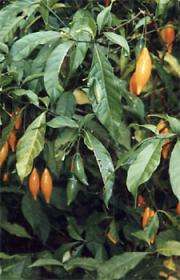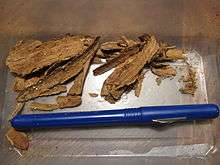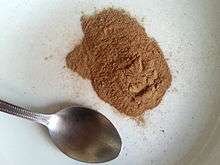Tabernanthe iboga
| Iboga | |
|---|---|
 | |
| Scientific classification | |
| Kingdom: | Plantae |
| (unranked): | Angiosperms |
| (unranked): | Eudicots |
| (unranked): | Asterids |
| Order: | Gentianales |
| Family: | Apocynaceae |
| Genus: | Tabernanthe |
| Species: | T. iboga |
| Binomial name | |
| Tabernanthe iboga (L.) Nutt. | |
Tabernanthe iboga or simply iboga is a perennial rainforest shrub and psychedelic, native to western Central Africa. Iboga stimulates the central nervous system when taken in small doses and induces visions in larger doses. In parts of Africa where the plant grows, the bark of the root is chewed for various pharmacological or ritualistic purposes. Ibogaine, the active alkaloid, is also used to treat substance abuse disorders and depression. A small amount of ibogaine, along with precursors of ibogaine are found in Voacanga africana.
Normally growing to a height of 2 m, T. iboga may eventually grow into a small tree up to 10 m tall, given the right conditions. It has small green leaves. Its flowers are white and pink, while the fruit can be either an elongated oval shape, or a round spherical shape, both having an orange colour. Its yellow-coloured roots contain a number of indole alkaloids, most notably ibogaine, which is found in the highest concentration in the root-bark. The root material, bitter in taste, causes an anaesthetic sensation in the mouth as well as systemic numbness to the skin.
Traditional use

The Iboga tree is the central pillar of the Bwiti spiritual practice in West-Central Africa, mainly Gabon, Cameroon and the Republic of the Congo, which uses the alkaloid-containing roots of the plant in a number of ceremonies. Iboga is taken in massive doses by initiates of this spiritual practice, and on a more regular basis is eaten in smaller doses in connection with rituals and tribal dances, which are usually performed at night. Bwitists have been subject to persecution by Catholic missionaries, who to this day are thoroughly opposed to the growing spiritual practice of Bwiti. Léon M'ba, before becoming the first President of Gabon in 1960, defended the Bwiti religion and the use of iboga in French colonial courts. On June 6, 2000, the Council of Ministers of the Republic of Gabon declared Tabernanthe iboga to be a national treasure.
In lower doses Iboga has a stimulant effect and is used to maintain alertness while hunting.[1][2]
Addiction treatment claims
Iboga extracts, as well as the purified alkaloid ibogaine, have attracted attention because of their purported ability to reverse addiction to recreational drugs such as alcohol and opiates. Anecdotal reports assert that administration of ibogaine reduces craving for opiates and cocaine for extended periods of time. Ibogaine is a k-opioid agonist which may be the reason it reduces opiate withdrawal symptoms. While some published data suggests that iboga derivatives attenuate drug- and ethanol-induced behaviors in rodents, no controlled studies in humans have been reported.[3]
Ibogaine is classified as a schedule 1 controlled substance in the United States, and is not approved there for addiction treatment (or any other therapeutic use) because of its hallucinogenic and cardiovascular side effects, as well as the absence of safety and efficacy data in human subjects.[4] In most other countries it remains unregulated and unlicensed.[3]
Independent ibogaine treatment clinics have emerged in Mexico, Canada, the Netherlands, South Africa, and New Zealand, all operating in what has been described as a "legal gray area".[3][5] Covert, illegal neighborhood clinics are also known to exist in the United States, despite active DEA surveillance.[2] Addiction specialists warn that the treatment of drug dependence with ibogaine in non-medical settings, without expert supervision and unaccompanied by appropriate psychosocial care, can be dangerous — and, in approximately one case in 300, potentially fatal.[5]
Legal status
Iboga is outlawed or restricted in Belgium, Poland, Denmark, Croatia, France,[6] Sweden, and Switzerland. In the United States Iboga is classified by the Controlled Substances Act on the list of schedule I drugs.[1][2]
Non-profit organization Föreningen för hollistisk missbruksvård (ibogain.se) is trying to convince the Swedish government to start up clinical investigations of its anti-addictive properties, loosen up the prohibition law against ibogaine, and allow the creation of treatment facilities in Sweden.
Exportation of iboga from Gabon is illegal since the passage of a 1994 cultural protection law.[7]

Conservation status
While little data is available on the exploitation and existing habitat of the iboga plant, the destructive effects of harvesting and slow growth could have already severely damaged the wild iboga population.[8]
Patents and applications
Here is a selection of iboga patents and patent applications filed in the last decade[1]
| US Patent or Application Number | Title | Owner/ Inventor | Comment |
|---|---|---|---|
| Application 20050288375,published 29 December 2005 | Method and composition for treating neurodegenerative disorders | Myriad Genetics,Salt Lake City, UT US | Claims ibogaine (and other compounds) used with an NSAID “for treating and preventing neurodegenerative disorders like Alzheimer's disease, dementia, mild cognitive impairment." |
| Application 20050222270 published 6 October 2005 and patent 5,958,919, issued 28 September 1999, and others | Prolonged administration of NMDA antagonist drug and safener drug to create improved stable neural homeostasis | Washington University, St.Louis, MO US | Use of ibogaine to enhance safety in a technique to “ease problems such as addictions to illegal or pain-killing drugs, nicotine, or alcohol, compulsive or criminal behavioral problems, severe depression, obsessive-compulsive disorders, phobias, etc." |
| Patent 6,416,793,issued 9 July 2002 | Formulations and use of controlled-release indolealkaloids | BioResponse,LLC, Boulder, CO, US | Ibogaine (and yohimbe) formulations with enhanced absorption by the body |
| Patent 6,348,456,issued 19 February 2002, and Application 20030153552,published 14 August 2003 | Method of treating chemical dependency in mammals and a composition therefor | Mash; Deborah C. (University of Miami professor)and co-inventors | Claims noribogaine, a variant of ibogaine suitable for pharmaceuticals, and its use to treat addiction to “heroin, cocaine, alcohol, nicotine, amphetamine, methamphetamine, opium, methadone, hycodan, morphine and caffeine." |
| Patent 6,211,360, issued 3 April 2001 | Ibogamine cogeners | Albany Medical College (Albany,NY, US) and the University of Vermont (US). | Ibogamine-derived compounds for treating drug addiction |
| Patent 5,616,575, issued 1 April 1997 | Bioactive tricyclicibogaine analogs | University of Minnesota, US and University of Miami, US | Ibogamine-derived compounds for treating drug addiction |
Documentary films about iboga
- Iboga, les hommes du bois sacré (2002)
- In this French-language film, Gilbert Kelner documents modern Bwiti practices and Babongo perspectives on iboga. Odisea broadcast a Spanish-dubbed version titled Los hombres de la madera ("The Men of the Wood").
- Ibogaine: Rite of Passage (2004)
- Directed by Ben Deloenen.[9] A 34-year-old heroin addict undergoes ibogaine treatment with Dr Martin Polanco at the Ibogaine Association, a clinic in Rosarito Mexico. Deloenen interviews people formerly addicted to heroin, cocaine, and methamphetamine, who share their perspectives about ibogaine treatment. In Gabon, a Babongo woman receives iboga root for her depressive malaise. Deloenen visually contrasts this Western, clinical use of ibogaine with the Bwiti use of iboga root bark, but emphasizes the Western context.
- "Babongo" (2005)
- In this episode (series 1, episode 4) of the English documentary series Tribe, presenter Bruce Parry ingests iboga during his time with the Babongo. BBC 2 aired the episode on 25 January 2005.[10]
See also
References
- 1 2 3 McGown, Jay (2006). "Out of Africa: Mysteries of Access and Benefit Sharing" (PDF). Edmonds Institute. Retrieved July 28, 2014.
- 1 2 3 Hunter, Aina (December 13, 2005). "Busted for Iboga". Village Voice. Retrieved July 28, 2014.
- 1 2 3 Hegarty, S. (13 April, 2012). Can a hallucinogen from Africa cure addiction? BBC News archive. Retrieved June 17, 2015.
- ↑ Ibogaine. Basic data - drugwarfacts.org Retrieved June 17, 2015
- 1 2 Ibogaine therapy for drug addiction. maps.org archive. Retrieved June 17, 2015.
- ↑ "Arrêté du 12 mars 2007 modifiant l'arrêté du 22 février 1990 fixant la liste des substances classées comme stupéfiants" [Decree of 12 March 2007 amending the Decree of 22 February 1990 establishing the list of substances classified as narcotics]. admi.net (in French). 2007. Retrieved July 28, 2014.
- ↑ "Loi n°2/94 du 23 décembre 1994 portant sur la protection des biens culturels" [Law No. 2/94 of 23 December 1994 on the protection of cultural property]. African Archaeology (in French). 2008. Retrieved July 28, 2014.
- ↑ Tonye, Mahop Marcelin et. al (March 2000). "State of Knowledge Study on Tabernanthe Iboga Baillon: A Report For The Central African Regional Program For The Environment" (PDF). Limbe Botanic Garden. Retrieved July 28, 2014.
- ↑ Ibogaine: Rite of Passage (2004) at the Internet Movie Database
- ↑ Tribe series 1, episode 4: "Babongo" (2005) at the Internet Movie Database
External links
- Plants of The Gods by Richard Evans Schultes and Albert Hofmann (Healing Arts Press, 1992)
- Adam, Eve and Iboga, Giorgio Samorini. (Originally published in Integration 4: 4-10)
- The Bwiti Religion and the psychoactive plant Tabernanthe iboga (Equatorial Africa), Giorgio Samorini. (Originally published in Integration 5: 105-114)
- Pharmacodynamics and Therapeutic Applications of Iboga and Ibogaine, Robert Goutarel, Otto Gollnholfer and Roger Sillans (Originally published in Psychedelic Monographs and Essays, 6:70-111 (1993).
- The Religion of Iboga or Bwiti of the Fang, P. Barabe. (originally published as "La religion d'Eboga ou le Bwiti des Fanges", Med. trop. 12(3):251-257, (May/June) 1982)
- Tabernanthe iboga in West African plants – A Photo Guide.
- African Spirit Medicine Patrick Haize writes in Vision Magazine about his experience getting treated at Crossroads Ibogaine Treatment Center in Rosarito, Mexico.
- Trips Beyond Addiction | Living Hero Radio Show and Podcast special. With Dimitri Mobengo Mugianis, Bovenga Na Muduma, Clare S. Wilkins, Brad Burge, Tom Kingsley Brown, Susan Thesenga, Bruce K. Alexander, PhD ~ the voices of ex-addicts, researchers from The Multidisciplinary Association for Psychedelic Studies and Ibogaine/Iboga/Ayahuasca treatment providers sharing their experiences in breaking addiction with native medicines. Jan 2013